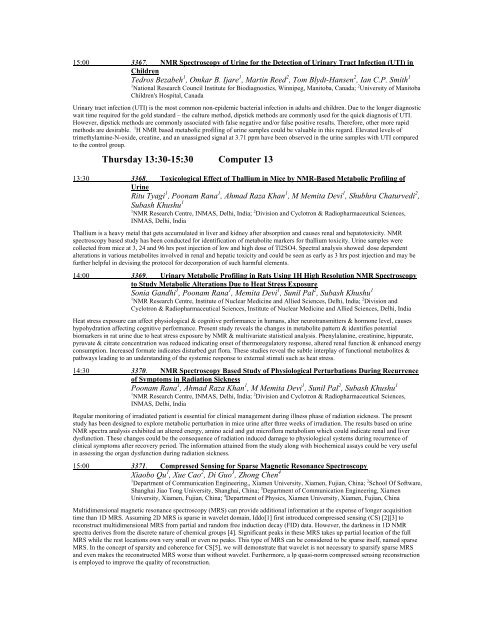ELECTRONIC POSTER - ismrm
ELECTRONIC POSTER - ismrm
ELECTRONIC POSTER - ismrm
You also want an ePaper? Increase the reach of your titles
YUMPU automatically turns print PDFs into web optimized ePapers that Google loves.
15:00 3367. NMR Spectroscopy of Urine for the Detection of Urinary Tract Infection (UTI) in<br />
Children<br />
Tedros Bezabeh 1 , Omkar B. Ijare 1 , Martin Reed 2 , Tom Blydt-Hansen 2 , Ian C.P. Smith 1<br />
1 National Research Council Institute for Biodiagnostics, Winnipeg, Manitoba, Canada; 2 University of Manitoba<br />
Children's Hospital, Canada<br />
Urinary tract infection (UTI) is the most common non-epidemic bacterial infection in adults and children. Due to the longer diagnostic<br />
wait time required for the gold standard – the culture method, dipstick methods are commonly used for the quick diagnosis of UTI.<br />
However, dipstick methods are commonly associated with false negative and/or false positive results. Therefore, other more rapid<br />
methods are desirable. 1 H NMR based metabolic profiling of urine samples could be valuable in this regard. Elevated levels of<br />
trimethylamine-N-oxide, creatine, and an unassigned signal at 3.71 ppm have been observed in the urine samples with UTI compared<br />
to the control group.<br />
Thursday 13:30-15:30 Computer 13<br />
13:30 3368. Toxicological Effect of Thallium in Mice by NMR-Based Metabolic Profiling of<br />
Urine<br />
Ritu Tyagi 1 , Poonam Rana 1 , Ahmad Raza Khan 1 , M Memita Devi 1 , Shubhra Chaturvedi 2 ,<br />
Subash Khushu 1<br />
1 NMR Research Centre, INMAS, Delhi, India; 2 Division and Cyclotron & Radiopharmaceutical Sciences,<br />
INMAS, Delhi, India<br />
Thallium is a heavy metal that gets accumulated in liver and kidney after absorption and causes renal and hepatotoxicity. NMR<br />
spectroscopy based study has been conducted for identification of metabolite markers for thallium toxicity. Urine samples were<br />
collected from mice at 3, 24 and 96 hrs post injection of low and high dose of Tl2SO4. Spectral analysis showed dose dependent<br />
alterations in various metabolites involved in renal and hepatic toxicity and could be seen as early as 3 hrs post injection and may be<br />
further helpful in devising the protocol for decorporation of such harmful elements.<br />
14:00 3369. Urinary Metabolic Profiling in Rats Using 1H High Resolution NMR Spectroscopy<br />
to Study Metabolic Alterations Due to Heat Stress Exposure<br />
Sonia Gandhi 1 , Poonam Rana 1 , Memita Devi 1 , Sunil Pal 2 , Subash Khushu 1<br />
1 NMR Research Centre, Institute of Nuclear Medicine and Allied Sciences, Delhi, India; 2 Division and<br />
Cyclotron & Radiopharmaceutical Sciences, Institute of Nuclear Medicine and Allied Sciences, Delhi, India<br />
Heat stress exposure can affect physiological & cognitive performance in humans, alter neurotransmitters & hormone level, causes<br />
hypohydration affecting cognitive performance. Present study reveals the changes in metabolite pattern & identifies potential<br />
biomarkers in rat urine due to heat stress exposure by NMR & multivariate statistical analysis. Phenylalanine, creatinine, hippurate,<br />
pyruvate & citrate concentration was reduced indicating onset of thermoregulatory response, altered renal function & enhanced energy<br />
consumption. Increased formate indicates disturbed gut flora. These studies reveal the subtle interplay of functional metabolites &<br />
pathways leading to an understanding of the systemic response to external stimuli such as heat stress.<br />
14:30 3370. NMR Spectroscopy Based Study of Physiological Perturbations During Recurrence<br />
of Symptoms in Radiation Sickness<br />
Poonam Rana 1 , Ahmad Raza Khan 1 , M Memita Devi 1 , Sunil Pal 2 , Subash Khushu 1<br />
1 NMR Research Centre, INMAS, Delhi, India; 2 Division and Cyclotron & Radiopharmaceutical Sciences,<br />
INMAS, Delhi, India<br />
Regular monitoring of irradiated patient is essential for clinical management during illness phase of radiation sickness. The present<br />
study has been designed to explore metabolic perturbation in mice urine after three weeks of irradiation. The results based on urine<br />
NMR spectra analysis exhibited an altered energy, amino acid and gut microflora metabolism which could indicate renal and liver<br />
dysfunction. These changes could be the consequence of radiation induced damage to physiological systems during recurrence of<br />
clinical symptoms after recovery period. The information attained from the study along with biochemical assays could be very useful<br />
in assessing the organ dysfunction during radiation sickness.<br />
15:00 3371. Compressed Sensing for Sparse Magnetic Resonance Spectroscopy<br />
Xiaobo Qu 1 , Xue Cao 2 , Di Guo 3 , Zhong Chen 4<br />
1 Department of Communication Engineering,, Xiamen University, Xiamen, Fujian, China; 2 School Of Software,<br />
Shanghai Jiao Tong University, Shanghai, China; 3 Department of Communication Engineering, Xiamen<br />
University, Xiamen, Fujian, China; 4 Department of Physics, Xiamen University, Xiamen, Fujian, China<br />
Multidimensional magnetic resonance spectroscopy (MRS) can provide additional information at the expense of longer acquisition<br />
time than 1D MRS. Assuming 2D MRS is sparse in wavelet domain, Iddo[1] first introduced compressed sensing (CS) [2][3] to<br />
reconstruct multidimensional MRS from partial and random free induction decay (FID) data. However, the darkness in 1D NMR<br />
spectra derives from the discrete nature of chemical groups [4]. Significant peaks in these MRS takes up partial location of the full<br />
MRS while the rest locations own very small or even no peaks. This type of MRS can be considered to be sparse itself, named sparse<br />
MRS. In the concept of sparsity and coherence for CS[5], we will demonstrate that wavelet is not necessary to sparsify sparse MRS<br />
and even makes the reconstructed MRS worse than without wavelet. Furthermore, a lp quasi-norm compressed sensing reconstruction<br />
is employed to improve the quality of reconstruction.
















